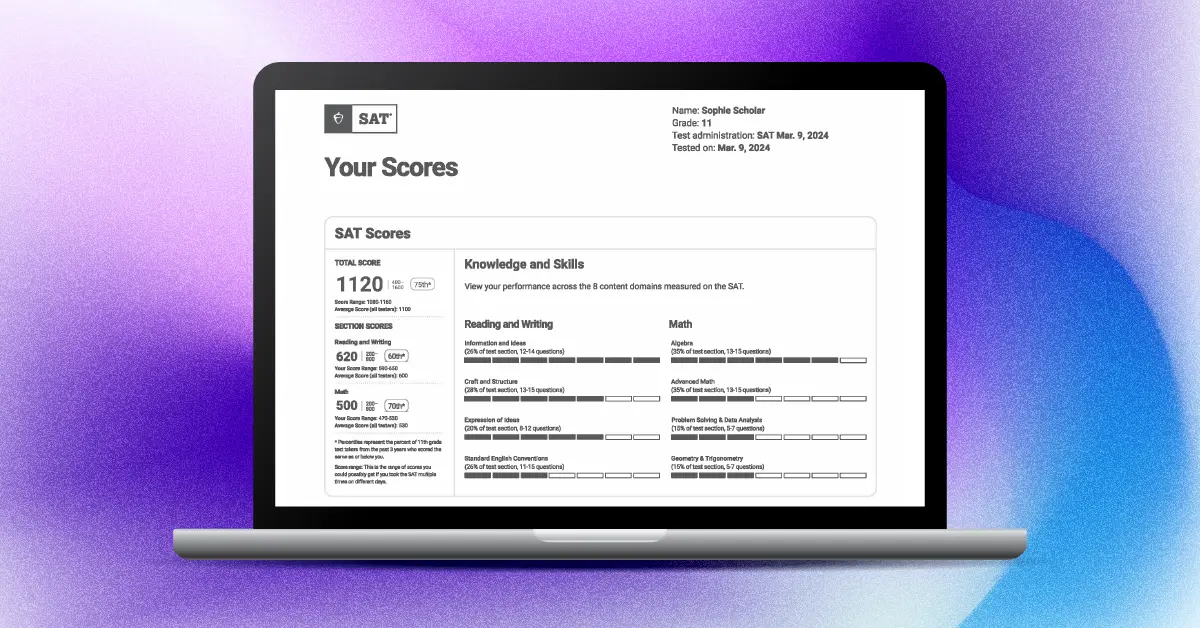Important SAT Update: Transition to Digital SAT
Effective December 3, 2023, the traditional paper-and-pencil format of the SAT has been discontinued. Starting in 2024, all students are required to take the Digital SAT, ushering in substantial changes in duration, format, material coverage, and question types. This shift to the Digital SAT represents a departure from traditional testing methods. It is crucial for students, educators, and test-takers to acquaint themselves with the new examination structure. Read more about the Digital SAT here.
A great way to prepare for the SAT® exam is by setting realistic expectations. It is important that you take time to recognize and learn from the most common mistakes made by students taking the SAT exam.
You can use this information in your test preparation and practice to do your best to avoid making the same mistakes. Many of these errors are preventable. Take note of the mistakes you can prevent through better study habits and the mistakes that could have been avoided through better test-taking strategies.
Here is a breakdown of the most common mistakes made in each section of the SAT exam:
Reading Test
Students’ most common mistakes in the SAT Reading exam are running out of time, misreading the question, ignoring contexts, and using outside sources to answer questions.
Running out of time is an easy mistake to make because of how much you are expected to accomplish during the Reading test. The reality is, unless you are a super speedy reader, this section of the exam will put pressure on your time management. Practice work is essential! Do your best to find a reading strategy that works for you and build up your test-taking endurance.
You are also likely to make mistakes if you slip up with your reading comprehension. Do not let wordiness or confusing question formats throw you off. Focus on details (like “most” versus “least”) when reading the questions.
You must pay attention to the type of passage you are reading, as contexts are crucial. Contexts can allow you to make predictions and build connections as you read. You can deepen your understanding of small details by paying attention to the main points they support or connect to. Ignoring the context of a passage is a mistake that you can avoid easily through practice and reading comprehension skills.
You should know that the questions in the Reading section of the SAT exam will never require your outside knowledge. Using outside information to answer a question about the passage can result in massive errors. Remember, this section of the exam assesses your skills with evidence from the text. Take advantage of any opportunity to show off those skills!
Writing Test
Mistakes in the Writing test can be attributed to studying errors and test-taking errors. Studying errors occur when a test taker ignores grammar rules when selecting answers. It is crucial that you practice your reasoning skills by pinpointing the grammar rule that produces the error or the improvement.
Developing this kind of habitual reasoning will help you avoid the mistake of using what sounds right to answer grammar questions. Note that this mistake is common because the SAT exam will deliberately trick you. Not all sentences that sound grammatically correct are grammatically correct. Focus on grammar rules and concision when making improvements.
You can also benefit by knowing the most commonly missed question types. Spend some extra time studying the rules for gerunds, dangling modifiers, idioms, pronouns, and faulty comparisons.
During the exam, be sure to avoid these common test-taking mistakes:
- Rushing
- Failing to understand what the question is asking
- Failing to read each answer choice.
Math Test
Errors on the Math exam can occur in your studying and on test day as well. Studying mistakes include failing to memorize formulas and missing out on function questions. Memorizing formulas is crucial, and many students fail to recognize how many formulas are necessary for your success on the SAT Math test.
There will be some geometry formulas provided in your test booklet. Still, you will need to memorize formulas to solve for percentages, mean, speed, probabilities, slope, the midpoint of a line, the distance between two points, the length of an arc, the area of an arc sector, and the sine, cosine, and tangent of an angle. You will also need to memorize the formula to solve for a variable using the quadratic equation.
Another common studying error to note occurs with function questions, which many students have not encountered in their high school curriculum. Students who have not worked with functions need to spend some time throughout their studies and practice tests ensuring they are prepared to answer questions that require them to read, translate, solve, and manipulate equations in function notation. You should know that you may also have to interpret or produce the graph of a function.
Math errors that occur through your testing strategy are calculator errors, time management errors, guessing errors, reading comprehension errors, and procedural errors.
- Calculator errors are likely when you are rushing or when you are unfamiliar with your device.
- Time management errors are likely when you don’t have a plan for each question type. It is crucial to create realistic expectations by evaluating the questions that slow you down in your practice work.
- Guessing errors can occur when guessing is unnecessary. You may find that you jump to guess when the question’s format or word choice is intimidating. Don’t let the SAT test’s deliberate confusion deter you from trying! You may find that a lot of the questions you are guessing on are solvable.
- Reading comprehension errors are common, so be sure that you are careful to understand what the question asks.
- Procedural errors occur when you miss a step or fail to show your work. While the SAT exam does not require you to show your work, it is incredibly helpful to detail your procedure.
If you make a mistake, you can come back to your scratch paper and pinpoint where you went wrong. This means that you can avoid starting entirely over with complicated problems. Showing your work prevents careless errors and forces you to slow down.
You can practice the skills and strategies for avoiding the SAT exam’s most common mistakes through UWorld’s SAT online learning tool. This preparation resource contains thousands of practice problems, performance tracking tools, and detailed question explanations to guide your studies and improve your weak points throughout the exam. Try it out!




